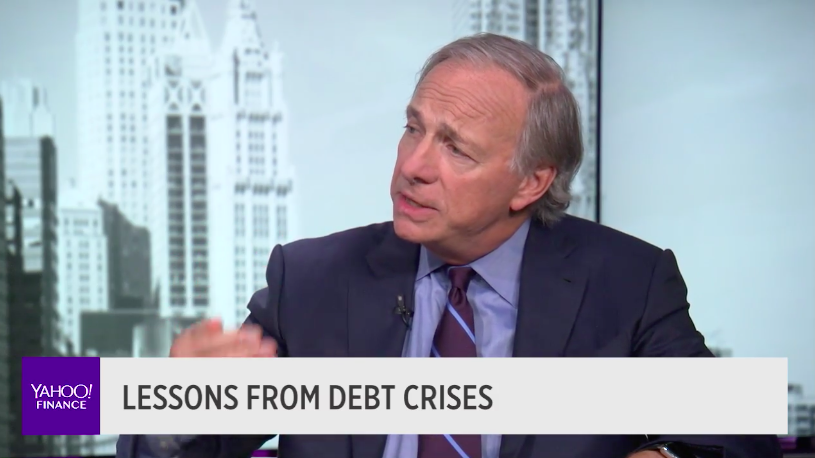Hedge fund titan Ray Dalio warns about what's coming in just 2 or 3 years
Hedge fund titan Ray Dalio, the founder of $160 billion Bridgewater Associates, sees another downturn on the horizon that could be more severe than 2008.
Dalio, who runs the largest and most profitable hedge fund firm, was one of the few investors able to anticipate and successfully navigate the 2008 financial crisis.
With the 10th anniversary of the crisis, the 69-year-old investor is now sharing the same principles that helped guide him in a new and free book called “A Template For Understanding Big Debt Crises.” It’s Dalio’s goal that this book can be used as a guide to reduce the likelihood of future debt crises and help them be managed better.
“The way I look at it is it’s like a disease, it’s like a process that happens over and over again,” Dalio said.

Leading up to the 2008 crisis, the red flags that Bridgewater Associates picked up on centered around debt.
“We had calculated that a number of the entities would not be able to pay back their debt. When there’s a certain rate of debt growth that is unsustainable and that there is going to be a problem paying it back, and you do the calculations, you could see that you have a problem,” Dalio explained. “When you start to have a debt problem and you’re close to 0% interest rates that means that the central bank the Federal Reserve’s ability to deal with that won’t work. You’ll hit zero and then enter a new world.”
In the book, he outlines and delves into the six stages of a debt cycle, which include: the early part of the cycle, the bubble, the top, the depression, the beautiful deleveraging, and pushing on a string/normalization.
The early part of the debt cycle is the “great part” because the debt growth is being used to finance activities that lead to fast income growth. This is what’s known as the “Goldilocks” period. Next is the bubble stage when debts rise faster than incomes and “everybody is extrapolating that because it happened in the past and because those assets went up they’re going to continue to go up.” In the bubble phase, borrowers feel rich and the spend more and buy assets using leverage.

The top of the cycle is usually triggered by central bank tightening and interest rate rise.
“So as we take a look at that we are approaching more of the top of that cycle. I don’t think we’re there yet. I think we’re in the seventh inning,” Dalio said. “When you have that tightening and then you have the turndown, and what I’ll call the depression phase, that depression phase happens because you hit 0% interest rates and because they’re less effective in monetary policy. That’s why 2008 was like it was in much 1930 was and so that’s the depression phase.”
Dalio believes that we are “relatively late” in this long-term debt cycle and the business cycle.
“That doesn’t mean imminent. I mean I think there are 2 or 3 more years probably in this. I’m not sure for sure.”
That said, he expects a downturn at some point, and it will be more severe than in 2008. What’s more, policymakers may have a limited ability to combat it.

“Downturns always come. Recessions always come. And what we have is a situation in which the capacities of the central banks to reverse it are more limited because interest rates are close to zero or at zero in Europe and Japan and also the effectiveness of monetary policy is largely, quantitative easing, is largely behind us because they have put that money and in those asset prices have risen.”
Another issue is the wealth gap that’s emerged since the 2008 crisis and the rise of populism.
“So imagine today we have the best economy that we’re going to get: the unemployment rate is low, the stock market is where it is, asset prices are good. These are times that are good, but we have this polarity. So if I’m looking at 2 or 3 years forward. That’s the period that produces greater concern.”
—
Julia La Roche is a finance reporter at Yahoo Finance. Follow her on Twitter. Send tips to laroche@oath.com.

 Yahoo Finance
Yahoo Finance 

